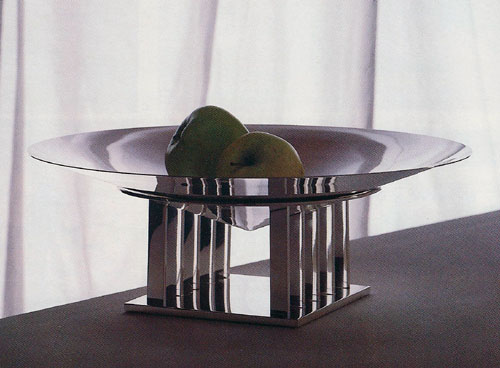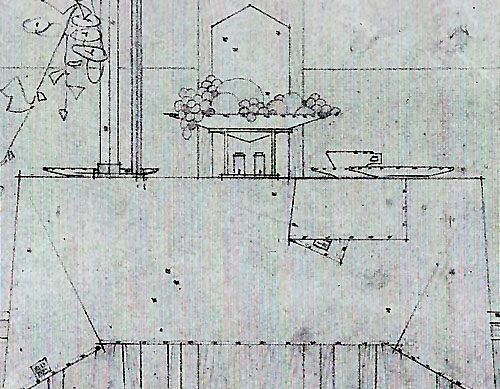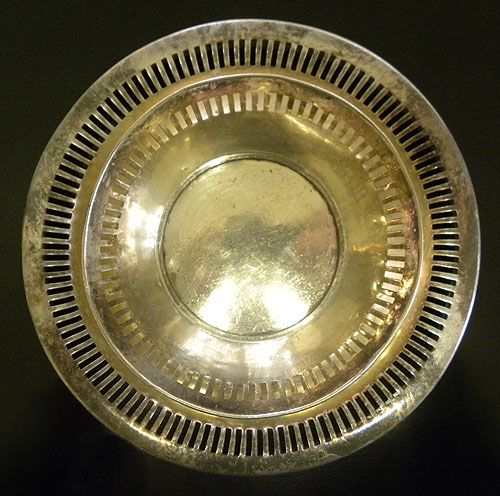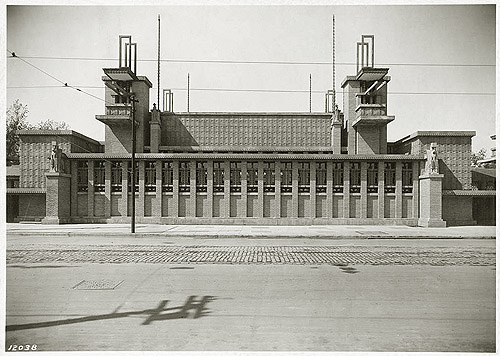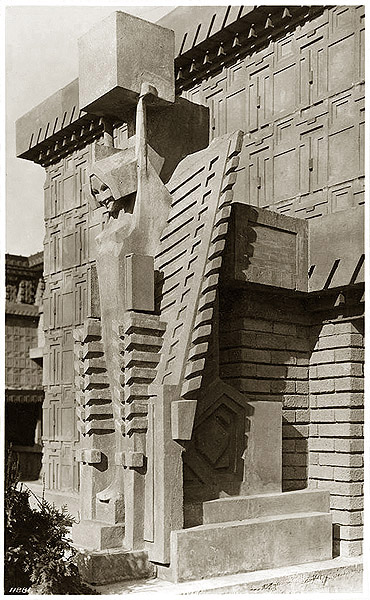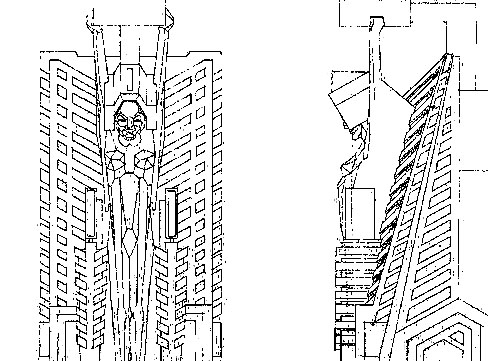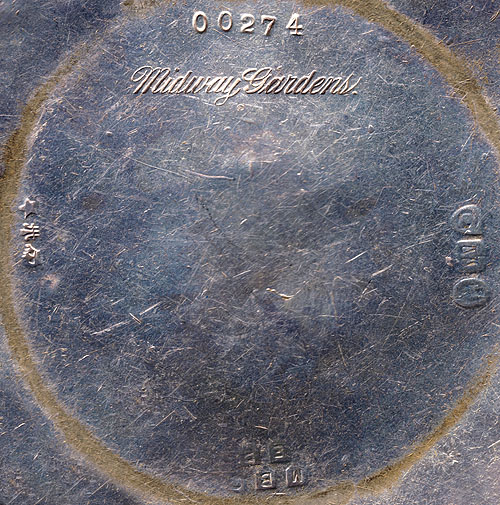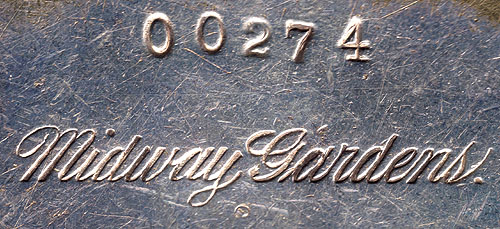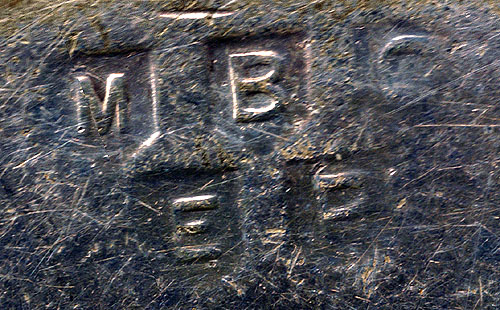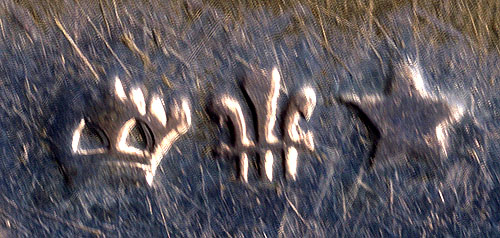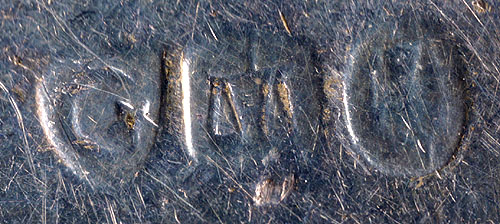|
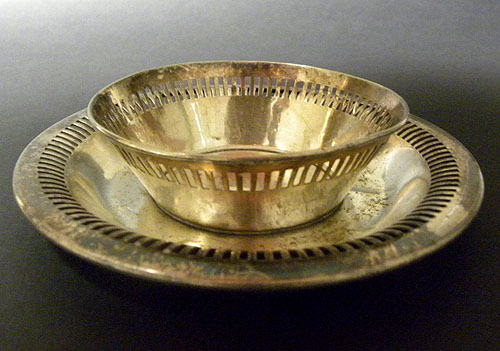 |
Wright designed many decorative
details for the Midway Gardens. Was this silver dish (above) produced
for Wright's Midway Gardens or some other? That was the question we
attempted to unravel. We did an extensive search through
everything that was published about the Midway Gardens. We
also contacted the Meriden Historical Society.
It is conclusive that Wright designed many
of the details and furnishings for the Midway Gardens.
Sculptures, vases, leaded glass windows, interior tables and chairs
(two designs,
M3 pl 493, 494),
garden furniture (two
variations,
M3 pl 497, 498),
linen,
lighting, china and a silver vase. He also designed the monogram that appeared on many items. Like the monograph
applied to items at the Imperial Hotel, the monograph appeared
on many items not designed by Wright like the Beer Stein (Fig.
5) and Tea Pot (Fig 7). It is also clear that
items were ordered that did not have Wright's touch. Wright
designed two versions of a garden table and chairs for the exterior
Summer Garden. This design was never executed. They chose a
white wood set
instead. A design for a beer stein (Fig. 5) was included in
one of Wright's drawings, and was more of a geometric design
than the one that was used and engraved with the Midway
Garden Monogram. The Coffee Pot Wright designed for Midway
Gardens was a variation of the design for the Imperial
Hotel (Fig 7c), very geometric in shape. Wright's design was not
selected. The Midway Gardens Coffee / Tea Pot was most
likely ordered from a catalog and imprinted with the MG
Monogram (Fig 2c).
Hence we come to this silver dish (above). First a number
of questions arise. Who manufactured it and when was
produced? Were there other Midway Gardens? We start with the
markings on the bottom.
Top: "00274, Midway Gardens" (Fig
10c). This
piece is numbered, but the Meriden Historical Society did
not have a record that matched. Of interest is the minute
mark between and below the "...y G..." in Midway Gardens. It
is approximately 1/64" in size. It is a stamped "W" inside a
"C". It resembles the original mark used by The Watrous Mfg.
Co., which merged with Meriden Britannia in 1898.
Bottom: "M B C E P" (Fig
10d). Each has raised letter
within a stamped box. This have been identified as Meriden Britannia Company Electro Plate.
Meriden, Connecticut, was the American capital for pewter
and silver manufacture in the 19th century. The Meriden
Britannia Company was formed in 1852, in Meriden, Conn. They
initially manufactured products using a metal alloy called
Britannia, approximating the appearance of pewter. In the
late 19th century, when silver began replacing pewter in
American homes, they also produced silver plated products. In 1898, they
were one of the major companies that formed International
Silver. MB continued to
use their marks into the 1930's. Some of the other companies
included:
Barbour Silver Company, Hartford, Conn.
C. Rogers & Brothers, Meriden, Conn
Derby Silver Company, Derby and Meriden, Conn.
Holmes & Edwards Silver Company, Bridgeport, Conn.
Manhattan Silver Plate, Lyons, New York
Meriden Britannia Company, Meriden |
|
Middletown Plate Company, Middletown and Meriden, Conn.
Norwich Cutlery, Norwich, Conn.
Rogers Cutlery, Hartford, Conn.
Rogers and Brothers, Waterbury, Conn.
Rogers and Hamilton, Waterbury, Conn.
Rogers, Smith & Co., Hartford, Conn.
Simpson, Hall, Miller & Company, Wallingford, Conn.
Simpson Nickel Company, Wallingford
Standard Silver Company, Ltd., Toronto, Canada
Watrous Manufacturing Company, Wallingford, Conn.
Wilcox Silver Plate, Meriden, Conn.
William Rogers Manufacturing Company, Hartford, Conn.
Each firm continued to stamp their maker's mark on
designs, but marketing and production was at the same
expanded facility.
Left: "Crown" with two triangles, "Wheat?",
"Star" (Fig 10e). All three are stamped, and unidentified.
Right: "Shield with small Star in a
Crescent" (Fig 10f). Note: Manhattan Silver
Plate, one of the companies that joined MB, had a Star
within a Crescent mark (TM p148). The second is a "Scale
within a Shield". Examples of this can be seen on MB items
as late as 1951. The third is a "Thistle within a Circle". All three are stamped.
After an exhaustive study of the markings
on the bottom of the piece, the conclusion seems to be that
the piece was produced after the merger in 1898, and before
1930, so it fits the time frame of Wright's MG.
Were there other Midway Gardens during that
time period? There may have been one or two, but it would
have had to have been a sizeable facility in order to place
an order like this and customized it with your name
imprinted and numbered. There were no other sizeable
"Midway Gardens" during that time period.
If this was used at Wright's MG, why would
this piece not have the MG monogram? It may have been
the size of the piece itself and its use. 1" in height, 5.5"
wide, with the smaller bowl being 3.75" wide. The MG
Cup and Saucer was designed without the monogram, and was
produced without it. There were a very
limited number of Imperial Hotel silver coffee
services that survived. Some were imprinted with the IH
monogram and some without. The only place for the monogram on this piece was the inside bottom of the dish, and if it
was used as a condiment, small serving bowl or candy dish,
the monogram would have been covered, hence no need to stamp
it in a visible area.
Of interest is the design itself. It is
consistent with Wright's geometric designs for Midway
Gardens. The perforated
setting surrounding the edges of the "bowl" and "tray"
mirrors the front of Midway Gardens (Fig 9d), the details of Wright's
"Queen of the Garden" sculpture (Fig
9e) and is stereotypical of
Wright's Prairie style.
Our summary is not conclusive, but we would
lean toward the conclusion that this silver dish was not
designed by Wright, but was used in Wright's Midway Gardens, and most
likely ordered from a catalog, and ordered in a quantity
that would allow Midway Gardens to imprint the bottom.
Text by Douglas M. Steiner, Copyright
2010. |
|
|
|
|
|
|
|
Midway
Gardens Timeline |
| 1913 |
Wright begins
designing Midway Gardens |
|
June 27th, 1914 |
Midway
Gardens officially opened |
|
September 1914 |
Henry
Fuermann & Sons photographs Midway Gardens |
|
May 31, 1916 |
Midway
Gardens was sold to the Edelweiss Brewery, renamed
Edelweiss Gardens |
|
1920 |
Prohibition was declared |
|
August 31, 1921 |
Sold to
E. C. Dietrich Midway Automobile Tire and Supply
Company and became the "Midway Dancing Gardens" |
|
October of 1923 |
Winter
Garden was revised and enlarged by removing
balconies |
|
1924 |
Benny Goodman plays at Midway
Gardens |
|
1925 |
Gilman Lane photographs Midway Dancing
Gardens |
|
Spring of 1929 |
Building leased to its final owner, Sinclair Filling
Station & Car Wash |
|
October 1929 |
Demolition of Midway Gardens begins |
| |
|
| |
Dates from “Frank Lloyd Wright and
Midway Gardens”, Kurty,1998 |
|
|
|
|
|
|
|
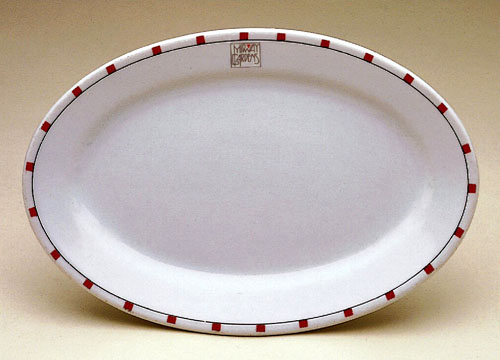 |
| 1:
Midway Gardens Oval Platter. Designed by Frank Lloyd
Wright. Manufactured by Bauscher, Weiden, Germany.
1914. Courtesy of The Minneapolis Institute of
Arts. |
| |
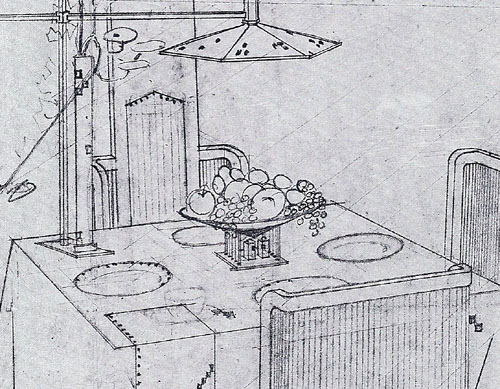 |
| 1b:
Table setting designed by Frank Lloyd Wright.
Includes example of plate design. Courtesy of the
Frank Lloyd Wright Foundation. |
| |
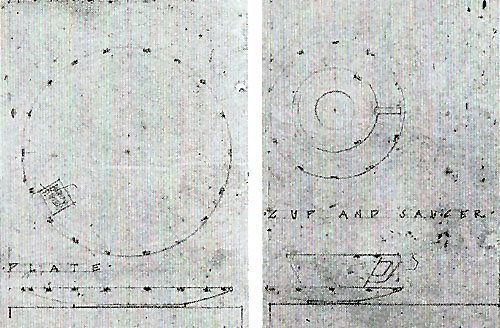 |
| 1b:
Detail of the Plate and the Cup and Saucer designed by Frank
Lloyd Wright. Plate design included MG monogram. Cup
and Saucer design lacked monogram, and was produced
without it. Courtesy of the Frank Lloyd Wright
Foundation. |
| |
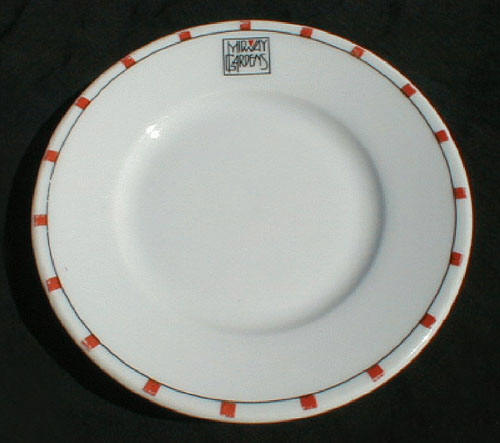 |
| 2:
Midway Gardens Plate. Designed by Frank Lloyd
Wright. Manufactured by Bauscher, Weiden, Germany.
1914. |
| |
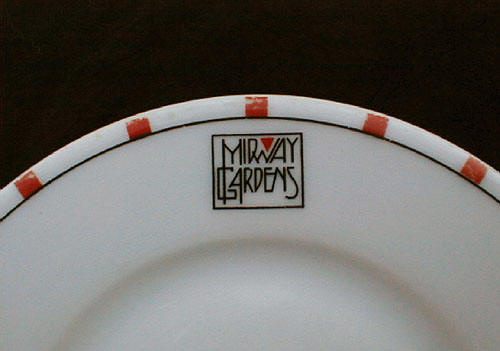 |
| 2b:
Detail of Midway Gardens Plate. Designed by Frank
Lloyd Wright. Manufactured by Bauscher, Weiden,
Germany. 1914. |
|
2c |
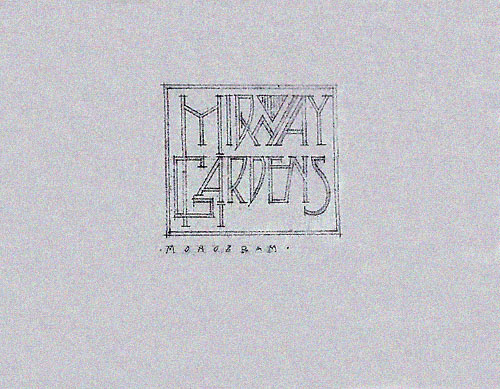 |
| 2c:
Midway Gardens Monogram designed by Frank
Lloyd Wright. Courtesy of the Frank Lloyd Wright
Foundation. |
| |
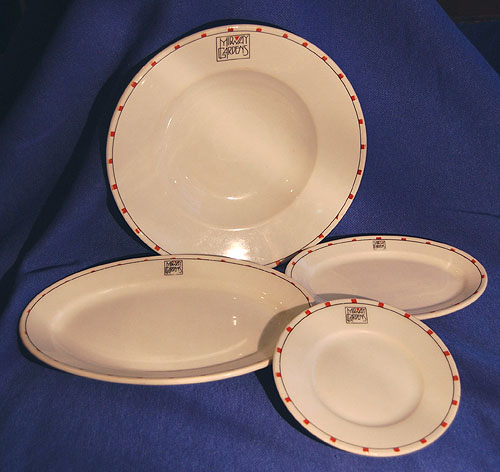 |
2d:
Midway Gardens Plates. Designed by Frank Lloyd
Wright.
All four are marked on the back with "New
York-Chicago Bauscher Weiden (Germany) 1914".
Top:
Large round soup or salad 9" across. Impressed mark
in oval "Bauscher Weiden", and impressed away from
the other marks is "23".
Center Left: Large platter. 9 3/4" by 6".
Impressed mark in oval "Bauscher Weiden", and
impressed away from the other marks is "00".
Center Right: Small platter. 7" by 4 1/4".
Impressed mark in oval "Bauscher Weiden", and
impressed away from the other marks is "00".
Foreground: Small round plate 6" across.
Impressed mark in oval "Bauscher Weiden", and
impressed away from the other marks is "15".
(The Impressed Numbers may have to do with the
shapes of the pieces. Two platters are marked with
"00". The small plate "15" and the large Bowl "23".)
All are manufactured by Bauscher, Weiden, Germany.
1914. Photograph courtesy of private collector. |
| |
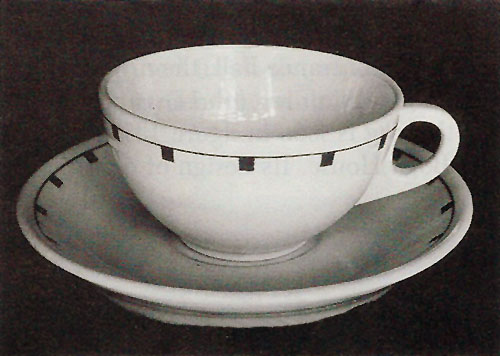 |
| 3:
Midway Gardens Cup and Saucer, 1914. Designed by Frank
Lloyd Wright. The Midway Gardens Cup and Saucer was designed
without the monogram, and was produced without it.
Note: Pattern is inversed on this Sup & Saucer.
Squares are below the line, not above like on all
the other patterns. This was John Lloyd Wright's Cup
& Saucer. It was manufactured by Shenango China, New
Castle not Bauscher, Weiden, Germany which
manufactured all the other Midway Gardens ceramics.
This could account for the difference. Courtesy of David Hanks,
Decorative
Designs, 1979, p 125. |
| |
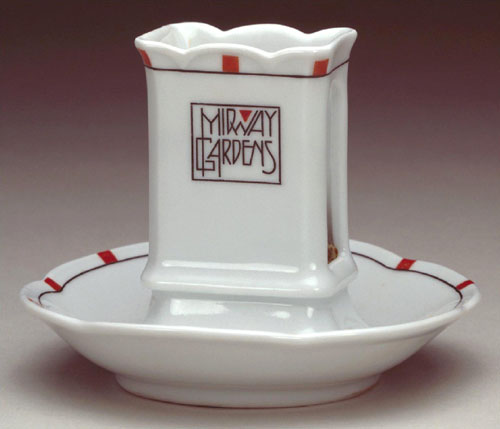 |
| 4:
Midway Gardens Ash Tray and Match Holder. Not
verified as a Wright designed. Most likely the red
squares and monogram adapted to ash tray. Manufactured by Bauscher, Weiden,
Germany. 1914. Courtesy of The Minneapolis Institute of
Arts. |
|
5 |
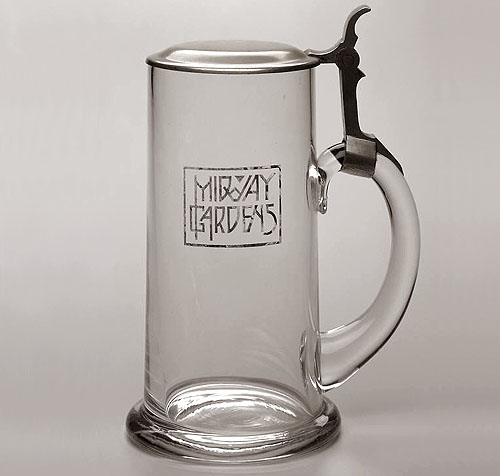 |
| 5:
Midway Gardens Beer Stein. Not verified as a Wright
designed. A design for a beer stein was
included in one of Wright's drawings, and was more
of a geometric design than this one that was used
and engraved with the Midway Garden Monogram. Glass
and pewter.
7" x 4" x 5". 1914. Courtesy
of The Minneapolis Institute of
Arts. |
| |
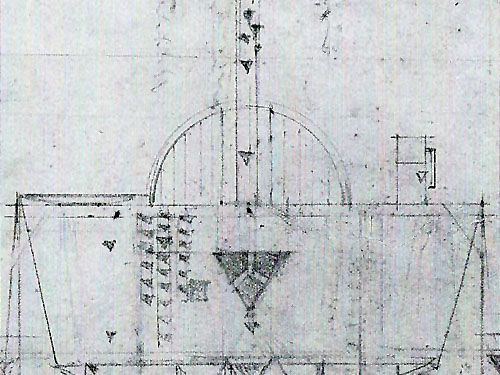 |
| 5b:
Detail of table setting with rendering of Wright's
concept for a Midway Gardens Beer Stein (right side
of table). Design was
never realized. Courtesy of the Frank Lloyd Wright
Foundation. |
| |
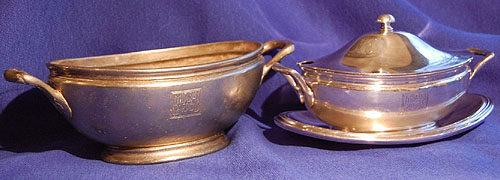 |
| 6:
Midway Gardens Soup Terrines with Midway
Gardens monogram. Left: Two Pint Soup Terrine.
9 5/8" long Handle to Handle by 4 3/4" wide by 3 1/4
Tall at the center. Right: One Pint
Soup Terrine.
8" long handle to handle by 4 1/4" Wide by 2 1/2"
Tall at the center. When combined, the One Pint
Soup
Tray, Terrine and Lid is 4 1/2" Tall to the top of
the lid. The owner purchased
the
One Pint Soup
Terrine at a
antique store in his neighborhood, which is no
longer in business. Photograph courtesy of private
collector. |
| |
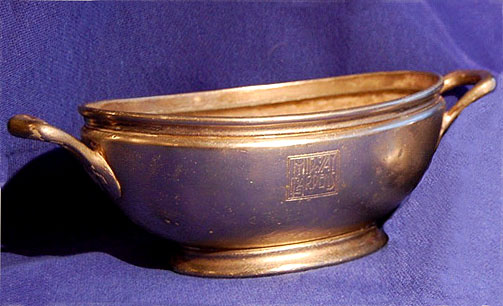 |
| 6b:
Midway Gardens Soup Terrine with Midway
Gardens monogram. Two Pint Soup Terrine.
9 5/8" long Handle to Handle by 4 3/4" wide by 3 1/4
Tall at the center.
Photograph courtesy of
private collector. |
| |
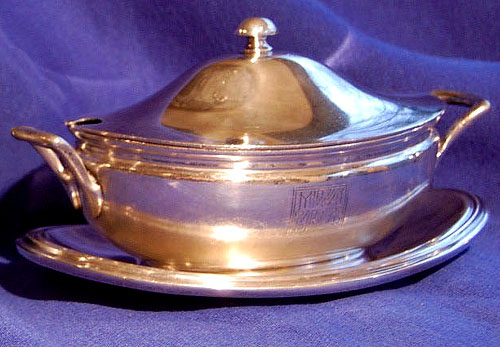 |
| 6c:
Midway Gardens Soup Terrine and Base with Midway
Gardens monogram.
One Pint Soup
Terrine.
8" long handle to handle by 4 1/4" Wide by 2 1/2"
Tall at the center. When combined, the One Pint
Soup
Tray, Terrine and Lid is 4 1/2" Tall to the top of
the lid. The owner purchased
the
One Pint Soup
Terrine at a
antique store in his neighborhood, which is no
longer in business. Photograph courtesy of private
collector. |
| |
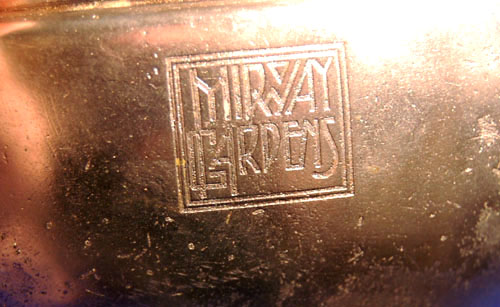 |
| 6d:
Detail of the Midway Gardens Soup Terrine's monogram. |
| |
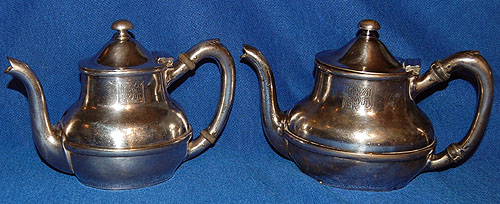 |
|
7: Midway Gardens Tea
Pots with Midway
Gardens monogram. Left: One Pint Tea Pot.
5 1/2" Tall by 7 1/2" Wide Handle to Spout. Right:
Two Pint Tea
Pot.
5 3/4" Tall by 8 1/2" Wide Handle to Spout.
Photograph courtesy of
private collector. |
| |
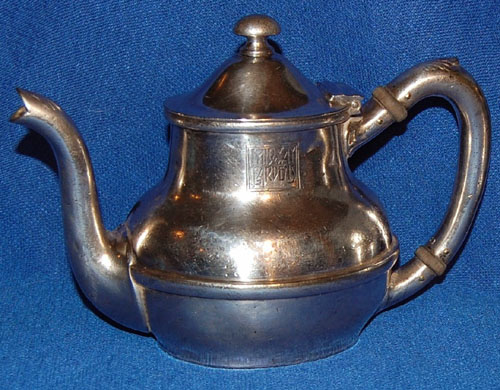 |
|
7b: Midway Gardens Tea
Pot with Midway
Gardens monogram. One Pint Tea Pot.
5 1/2" Tall by 7 1/2" Wide Handle to Spout.
Photograph courtesy of
private collector. |
| |
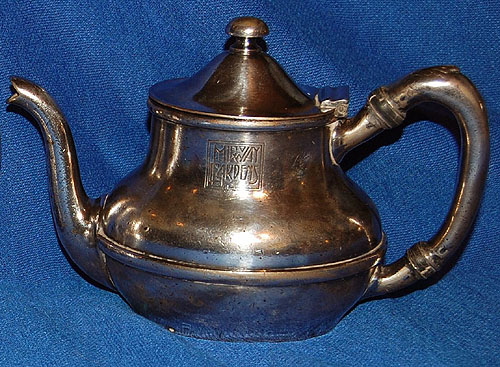 |
|
7c: Midway Gardens Tea
Pot with Midway
Gardens monogram. Two Pint Tea Pot.
5 3/4" Tall by 8 1/2" Wide Handle to Spout.
Photograph courtesy of
private collector. |
| |
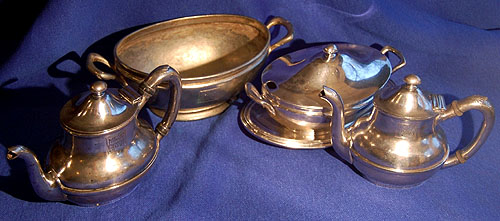 |
|
8:
Midway Gardens Soup Terrines (2) and Tea Pots (2) with Midway
Gardens monogram. Left to Right: Two Pint Tea Pot,
Two Pint Soup Terrine, One Pint Soup Terrine with
Tray and Lid, One Pint Tea Pot. Photograph courtesy of
private collector. |
|
7 |
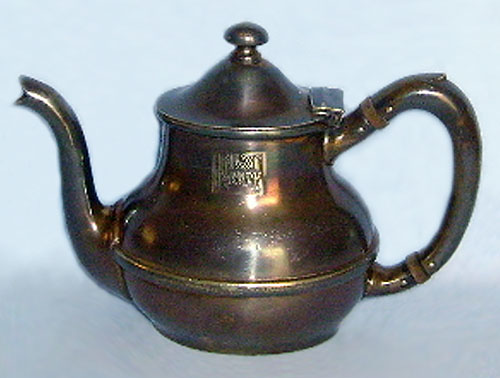 |
9:
Midway Gardens Tea Pot. The Coffee Pot Wright
designed for Midway Gardens was a variation of the
design for the Imperial
Hotel, very geometric in shape. Wright's design was not
selected. This Midway Gardens Coffee / Tea Pot was most
likely ordered from a catalog and imprinted with the MG
Monogram. 1914.
History of this Tea Pot: My Great Aunt and
Uncle lived in Joliet, and used to visit Midway
Gardens back in the 1920's, they loved the
restaurant and the bands that played there. They
were at the restaurant on one of their visits and my
Great Aunt did not feel well that evening, as she
thought she might be expecting a Baby. The tea that
evening was the only thing that calmed her, so she
had their chauffeur purchase a tea pot full of hot
water and the cup of tea for the drive home. Over
the years she told our family about the unpleasant
drive home from that evening, and the other
exciting evenings at Midway Gardens. Courtesy
of Jeanne, Happy Trails, Ruby Lane. |
| |
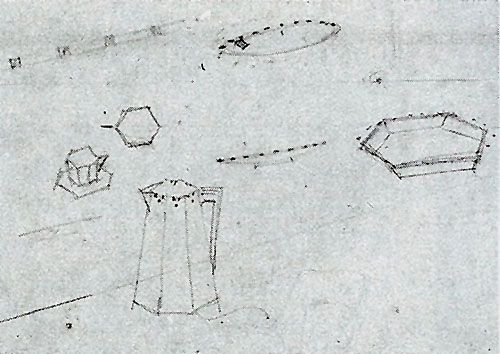 |
| 9b:
Detail of Wright's
concept for a Midway Gardens Coffee Server. The
designed was a variation of the design for the Imperial
Hotel, very geometric in shape. Design was
never realized. Courtesy of the Frank Lloyd Wright
Foundation. |
|
7c |
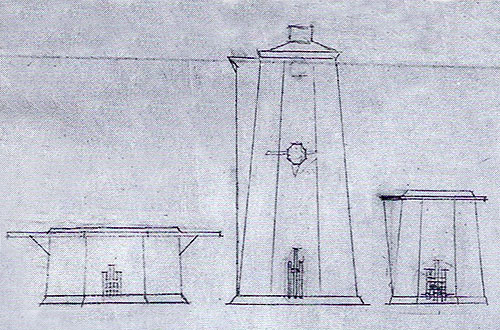 |
| 9c: Detail of Wright's concept for a
Imperial Hotel Coffee
Server. Courtesy of the Frank Lloyd Wright
Foundation. |
| |
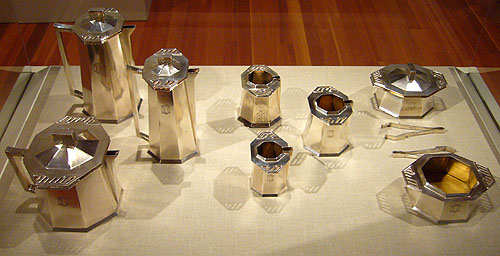 |
| 9d: Imperial Hotel Coffee
Server on display at the de
Young Museum, San Francisco in 2006. On loan from a
private party. Courtesy of Eric.
(Treasured Hunting) |
|
|
|
























